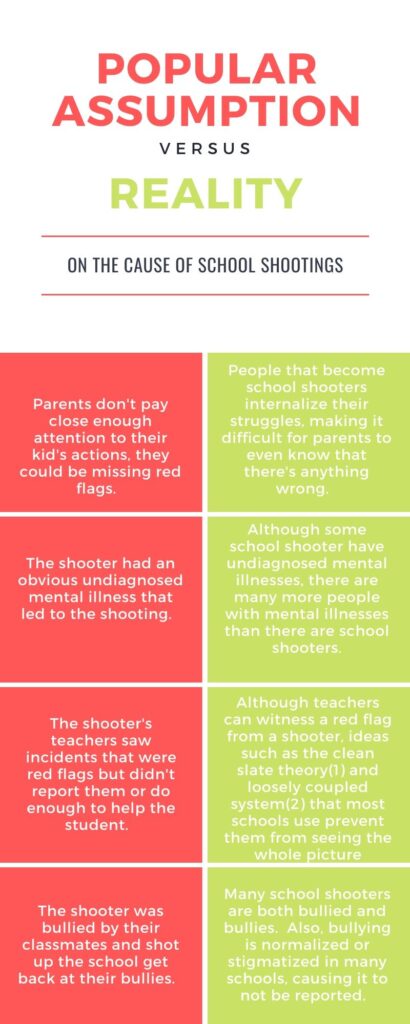
Even though shootings are frequent and even normalized by some people, there are many misconceptions about the circumstances that create a school shooter. In sharing this graphic, I hope to bring awareness to these misconceptions and the realities of how school shooters can go unnoticed.
Nowadays, school shootings are so common in the United States that news videos reporting on them attract comments like “As an American I’m surprised I haven’t dealt with a school shooting”(Mai, 2020). Other commenters blame others for allowing the shooter to cause such devastation. Through looking at the comment sections on videos covering both the Stoneman Douglas High School shooting and the Santa Fe High School shooting, I was able to identify four common sources of blame for the shooter’s actions: lack of parental supervision, mental illness, lack of teacher intervention, and bullying. However, through reading Katherine Newman’s book titled Rampage on the sociological roots of school shootings, I learned more about the flaws in these four statements often found in pop culture. In my table, I outlined the four popular assumptions on the causes of school shootings followed by an explanation for each that challenges it.
Overall, I believe that when a person becomes a school shooter, the blame can’t be placed on any one individual or factor. It’s a much more complicated subject that involves multiple broken systems, including the school and community, that ultimately lead to those individual factors becoming a problem. Therefore, I think the blame should shift from an individual focus to one that holds faulty systems accountable.
Definitions:
- Clean slate theory is the belief that students should not have a trail of paperwork describing their behavior following them from grade to grade, thus having a clean slate each school year. This belief manifests itself in schools all over the United States due to teachers’ and school administrators’ desire to not have a student’s past behaviors bias a new teacher’s impression of them.
- Loosely coupled systems are organizations whose parts are not tightly connected to each other. Thus, when when one part of the organization fails to function properly, the other parts are not affected and the system can still function. On the other hand, if one part of a tightly coupled system fails, the whole system will be affected.
Works Cited
Mai, Gacha. Comment on “17 dead in ‘horrific’ high school shooting”. Youtube, February 2020, https://www.youtube.com/watch?v=xgIJosk0pnA.
Newman, Katherine S. Rampage: Social Roots of School Shootings. Perseus Books, LLC, 2005.